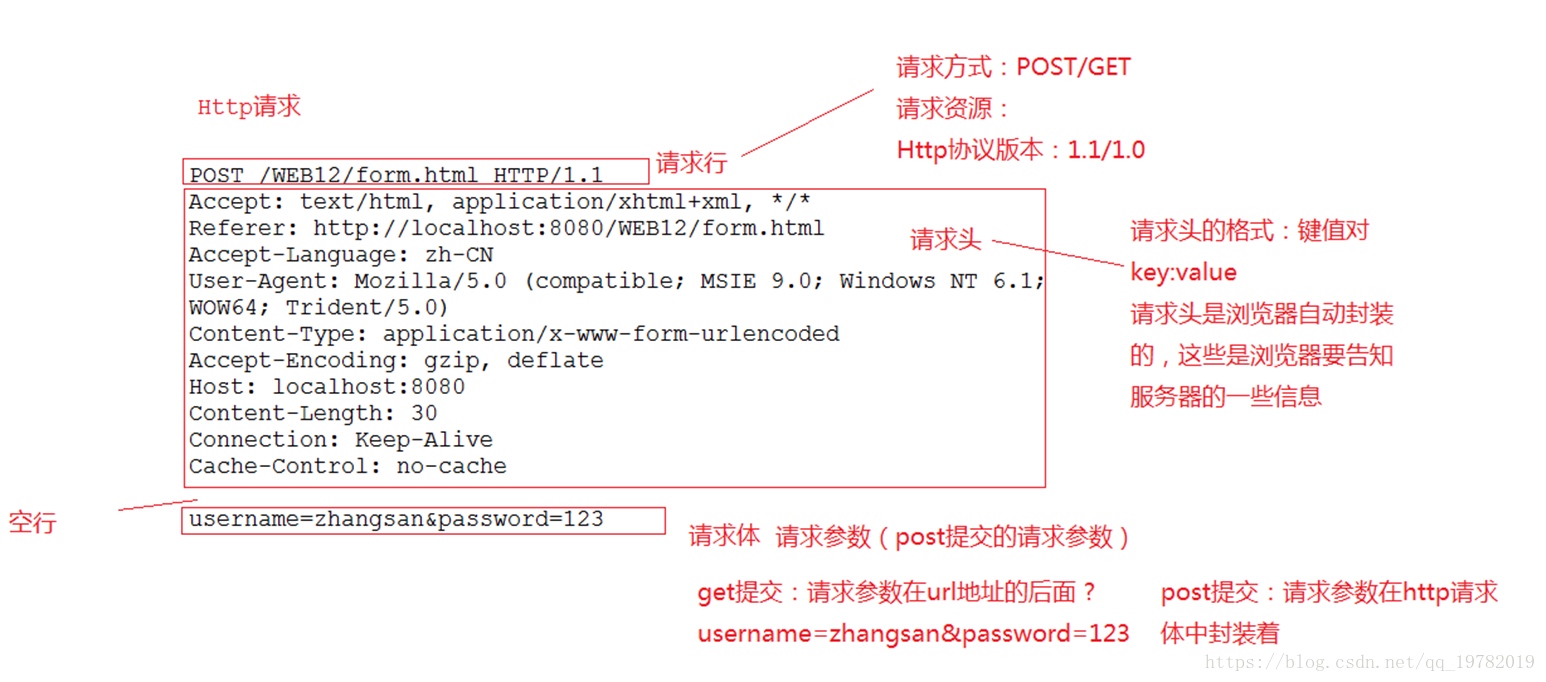HttpServletRequest对象
一、HttpServletRequest介绍
HttpServletRequest对象代表客户端的请求,当客户端通过HTTP协议访问服务器时,HTTP请求头中的所有信息都封装在这个对象中,通过这个对象提供的方法,可以获得客户端请求的所有信息。

二、Request常用方法
2.1、获得客户机信息
getRequestURL方法返回客户端发出请求时的完整URL。
getRequestURI方法返回请求行中的资源名部分。
getQueryString方法返回请求行中的参数部分。
getPathInfo方法返回请求URL中的额外路径信息。额外路径信息是请求URL中的位于Servlet的路径之后和查询参数之前的内容,它以“/”开头。
getRemoteAddr方法返回发出请求的客户机的IP地址。
getRemoteHost方法返回发出请求的客户机的完整主机名。
getRemotePort方法返回客户机所使用的网络端口号。
getLocalAddr方法返回WEB服务器的IP地址。
getLocalName方法返回WEB服务器的主机名。
范例:通过request对象获取客户端请求信息
package com.lovo.study;
import java.io.IOException;
import java.io.PrintWriter;
import javax.servlet.ServletException;
import javax.servlet.http.HttpServlet;
import javax.servlet.http.HttpServletRequest;
import javax.servlet.http.HttpServletResponse;
public class RequestDemo extends HttpServlet {
private static final long serialVersionUID = 1L;
public RequestDemo() {
super();
}
protected void doGet(HttpServletRequest request, HttpServletResponse response) throws ServletException, IOException {
/**
* 1.获得客户机信息
*/
String requestUrl = request.getRequestURL().toString();//得到请求的URL地址
String requestUri = request.getRequestURI();//得到请求的资源
String queryString = request.getQueryString();//得到请求的URL地址中附带的参数
String remoteAddr = request.getRemoteAddr();//得到来访者的IP地址
String remoteHost = request.getRemoteHost();//得到来访者的主机地址
int remotePort = request.getRemotePort();//得到来访者的端口号
String remoteUser = request.getRemoteUser();
String method = request.getMethod();//得到请求URL地址时使用的方法
String pathInfo = request.getPathInfo();
String localAddr = request.getLocalAddr();//获取WEB服务器的IP地址
String localName = request.getLocalName();//获取WEB服务器的主机名
response.setCharacterEncoding("UTF-8");//设置将字符以"UTF-8"编码输出到客户端浏览器
//通过设置响应头控制浏览器以UTF-8的编码显示数据,如果不加这句话,那么浏览器显示的将是乱码
response.setHeader("content-type", "text/html;charset=UTF-8");
PrintWriter out = response.getWriter();
out.write("获取到的客户机信息如下:");
out.write("<hr/>");
out.write("请求的URL地址:"+requestUrl);
out.write("<br/>");
out.write("请求的资源:"+requestUri);
out.write("<br/>");
out.write("请求的URL地址中附带的参数:"+queryString);
out.write("<br/>");
out.write("来访者的IP地址:"+remoteAddr);
out.write("<br/>");
out.write("来访者的主机名:"+remoteHost);
out.write("<br/>");
out.write("使用的端口号:"+remotePort);
out.write("<br/>");
out.write("remoteUser:"+remoteUser);
out.write("<br/>");
out.write("请求使用的方法:"+method);
out.write("<br/>");
out.write("pathInfo:"+pathInfo);
out.write("<br/>");
out.write("localAddr:"+localAddr);
out.write("<br/>");
out.write("localName:"+localName);
}
protected void doPost(HttpServletRequest request, HttpServletResponse response) throws ServletException, IOException {
doGet(request, response);
}
}
2.2、获得客户机请求头
getHeader(string name)方法:返回String 根据请求头的名字获取对应的请求头的值
getHeaders(String name)方法:返回Enumeration 根据请求头的名字获取对应的请求头的多个值(枚举)
getHeaderNames()方法:返回Enumeration 返回所有请求头(枚举)
package com.lovo.study;
import java.io.IOException;
import java.io.PrintWriter;
import java.util.Enumeration;
import javax.servlet.ServletException;
import javax.servlet.http.HttpServlet;
import javax.servlet.http.HttpServletRequest;
import javax.servlet.http.HttpServletResponse;
public class RequestDemo02 extends HttpServlet {
private static final long serialVersionUID = 1L;
public RequestDemo02() {
super();
}
protected void doGet(HttpServletRequest request, HttpServletResponse response) throws ServletException, IOException {
response.setCharacterEncoding("UTF-8");//设置将字符以"UTF-8"编码输出到客户端浏览器
//通过设置响应头控制浏览器以UTF-8的编码显示数据
response.setHeader("content-type", "text/html;charset=UTF-8");
PrintWriter out = response.getWriter();
Enumeration<String> reqHeadInfos = request.getHeaderNames();//获取所有的请求头
out.write("获取到的客户端所有的请求头信息如下:");
out.write("<hr/>");
while (reqHeadInfos.hasMoreElements()) {
String headName = (String) reqHeadInfos.nextElement();
String headValue = request.getHeader(headName);//根据请求头的名字获取对应的请求头的值
out.write(headName+":"+headValue);
out.write("<br/>");
}
out.write("<br/>");
out.write("获取到的客户端Accept-Encoding请求头的值:");
out.write("<hr/>");
String value = request.getHeader("Accept-Encoding");//获取Accept-Encoding请求头对应的值
out.write(value);
Enumeration<String> e = request.getHeaders("Accept-Encoding");
while (e.hasMoreElements()) {
String string = (String) e.nextElement();
System.out.println(string);
}
}
protected void doPost(HttpServletRequest request, HttpServletResponse response) throws ServletException, IOException {
doGet(request, response);
}
}
2.3、获得客户机请求参数(客户端提交的数据)
getParameter(String)方法(常用) getParameterValues(String name)方法(常用) getParameterNames()方法(不常用) getParameterMap()方法(编写框架时常用)
有以下jsp的form表单文件:
<%@ page language="java" contentType="text/html; charset=UTF-8"
pageEncoding="UTF-8"%>
<!DOCTYPE html>
<html lang="zh-CN">
<head>
<meta name="viewport"
content="width=device-width, initial-scale=1, maximum-scale=1, user-scalable=no">
<meta http-equiv="Content-Type" content="text/html; charset=UTF-8">
<!-- 新 Bootstrap 核心 CSS 文件 -->
<link rel="stylesheet" href="css/bootstrap.css">
<title>Insert title here</title>
</head>
<body>
<div class="container">
<form class="form-horizontal" action="${pageContext.request.contextPath }/RequestDemo03" method="post">
<fieldset>
<div id="legend" class="">
<legend class="">学生信息</legend>
</div>
<div class="control-group">
<!-- Text input-->
<label class="control-label" for="input01">工号(文本框)</label>
<div class="controls">
<input type="text" name="userId" placeholder="工号" class="input-xlarge">
<p class="help-block"></p>
</div>
</div>
<div class="control-group">
<!-- Text input-->
<label class="control-label" for="input01">姓名(文本框)</label>
<div class="controls">
<input type="text" name="userName" placeholder="姓名" class="input-xlarge">
<p class="help-block"></p>
</div>
</div>
<div class="control-group">
<!-- Text input-->
<label class="control-label" for="input01">密码(密码框)</label>
<div class="controls">
<input type="password" name="userPwd" placeholder="密码" class="input-xlarge">
<p class="help-block"></p>
</div>
</div>
<div class="control-group">
<label class="control-label">性别(单选框)</label>
<div class="controls">
<!-- Inline Radios -->
<label class="radio inline">
<input type="radio" value="男"
name="sex" checked="checked"> 男
</label>
<label class="radio inline">
<input type="radio"
value="女" name="sex"> 女
</label>
</div>
</div>
<div class="control-group">
<!-- Select Basic -->
<label class="control-label">学历(下拉框)</label>
<div class="controls">
<select class="input-xlarge" name="education">
<option value="高中">高中</option>
<option value="专科">专科</option>
<option value="本科">本科</option>
<option value="硕士">硕士</option>
<option value="博士">博士</option>
</select>
</div>
</div>
<div class="control-group">
<label class="control-label">兴趣(多选框)</label>
<!-- Multiple Checkboxes -->
<div class="controls">
<!-- Inline Checkboxes -->
<label class="checkbox inline"> <input type="checkbox"
value="唱歌" name="interest"> 唱歌
</label> <label class="checkbox inline"> <input type="checkbox"
value="跳舞" name="interest"> 跳舞
</label> <label class="checkbox inline"> <input type="checkbox"
value="运动" name="interest"> 运动
</label> <label class="checkbox inline"> <input type="checkbox"
value="游戏" name="interest"> 游戏
</label> <label class="checkbox inline"> <input type="checkbox"
value="阅读" name="interest"> 阅读
</label>
</div>
</div>
<div class="control-group">
<!-- Textarea -->
<label class="control-label">说明(文本域)</label>
<div class="controls">
<div class="textarea">
<textarea type="" class="" name="note"> </textarea>
</div>
</div>
</div>
<!--隐藏域,在页面上无法看到,专门用来传递参数或者保存参数-->
<input type="hidden" name="hiddenField" value="hiddenvalue"/>
<div class="control-group">
<div class="controls">
<button type="submit" class="btn btn-success">确定</button>
<button type="reset" class="btn btn-default">取消</button>
</div>
</div>
</fieldset>
</form>
</div>
</body>
</html>
servlet页面接受参数:
package com.lovo.study;
import java.io.IOException;
import java.text.MessageFormat;
import java.util.Map;
import javax.servlet.ServletException;
import javax.servlet.http.HttpServlet;
import javax.servlet.http.HttpServletRequest;
import javax.servlet.http.HttpServletResponse;
public class RequestDemo03 extends HttpServlet {
private static final long serialVersionUID = 1L;
public RequestDemo03() {
super();
}
protected void doGet(HttpServletRequest request, HttpServletResponse response)
throws ServletException, IOException {
// 客户端是以UTF-8编码提交表单数据的,
// 所以需要设置服务器端以UTF-8的编码进行接收,否则对于中文数据就会产生乱码
request.setCharacterEncoding("UTF-8");
String userId = request.getParameter("userId");
String userName = request.getParameter("userName");// 获取填写的用户名
String userPwd = request.getParameter("userPwd");// 获取填写的密码
String sex = request.getParameter("sex");// 获取选中的性别
String education = request.getParameter("education");// 获取选中的学历
// 获取选中的兴趣,因为可以选中多个值,所以获取到的值是一个字符串数组,因此需要使用getParameterValues方法来获取
String[] insts = request.getParameterValues("interest");
String note = request.getParameter("note");// 获取填写的说明信息
String hiddenField = request.getParameter("hiddenField");// 获取隐藏域的内容
String instStr="";
/**
* 获取数组数据的技巧,可以避免insts数组为null时引发的空指针异常错误!
*/
for (int i = 0; insts!=null && i < insts.length; i++) {
if (i == insts.length-1) {
instStr+=insts[i];
}else {
instStr+=insts[i]+",";
}
}
String htmlStr = "<table>" +
"<tr><td>填写的编号:</td><td>{0}</td></tr>" +
"<tr><td>填写的用户名:</td><td>{1}</td></tr>" +
"<tr><td>填写的密码:</td><td>{2}</td></tr>" +
"<tr><td>选中的性别:</td><td>{3}</td></tr>" +
"<tr><td>选中的部门:</td><td>{4}</td></tr>" +
"<tr><td>选中的兴趣:</td><td>{5}</td></tr>" +
"<tr><td>填写的说明:</td><td>{6}</td></tr>" +
"<tr><td>隐藏域的内容:</td><td>{7}</td></tr>" +
"</table>";
htmlStr = MessageFormat.format(htmlStr, userId,userName,userPwd,sex,education,instStr,note,hiddenField);
response.setCharacterEncoding("UTF-8");//设置服务器端以UTF-8编码输出数据到客户端
response.setContentType("text/html;charset=UTF-8");//设置客户端浏览器以UTF-8编码解析数据
response.getWriter().write(htmlStr);//输出htmlStr里面的内容到客户端浏览器显示
//在服务器端使用getParameterNames方法接收表单参数,代码如下:
//注意使用此方法如果出现checkbox这种多个结果的,就只能获取一个结果
//Enumeration<String> paramNames = request.getParameterNames();//获取所有的参数名
//while (paramNames.hasMoreElements()) {
//String name = paramNames.nextElement();//得到参数名
//String value = request.getParameter(name);//通过参数名获取对应的值
//System.out.println(MessageFormat.format("{0}={1}", name,value));
//}
//request对象封装的参数是以Map的形式存储的
// Map<String, String[]> paramMap = request.getParameterMap();
// for(Map.Entry<String, String[]> entry :paramMap.entrySet()){
// String paramName = entry.getKey();
// String paramValue = "";
// String[] paramValueArr = entry.getValue();
// for (int i = 0; paramValueArr!=null && i < paramValueArr.length; i++) {
// if (i == paramValueArr.length-1) {
// paramValue+=paramValueArr[i];
// }else {
// paramValue+=paramValueArr[i]+",";
// }
// }
// System.out.println(MessageFormat.format("{0}={1}", paramName,paramValue));
// }
}
protected void doPost(HttpServletRequest request, HttpServletResponse response)
throws ServletException, IOException {
doGet(request, response);
}
}
三、request接收表单提交中文参数乱码问题
在service中使用的编码解码方式默认为:ISO-8859-1编码,但此编码并不支持中文,因此会出现乱码问题,所以我们需要手动修改编码方式为UTF-8编码,才能解决中文乱码问题
1、如果提交方式为post,想不乱码,只需要在服务器端设置request对象的编码即可,客户端以哪种编码提交的,服务器端的request对象就以对应的编码接收,比如客户端是以UTF-8编码提交的,那么服务器端request对象就以UTF-8编码接收
request.setCharacterEncoding("UTF-8")
2、如果提交方式为get,设置request对象的编码是无效的,request对象还是以默认的ISO8859-1编码接收数据,因此要想不乱码,只能在接收到数据后再手工转换,步骤如下:
1).获取获取客户端提交上来的数据,得到的是乱码字符串,data="???è?????"
String data = request.getParameter("paramName");
2).查找ISO8859-1码表,得到客户机提交的原始数据的字节数组
byte[] source = data.getBytes("ISO8859-1");
3).通过字节数组以指定的编码构建字符串,解决乱码
data = new String(source, "UTF-8");
四、Request对象实现请求转发
4.1、请求转发的基本概念
请求转发:指一个web资源收到客户端请求后,通知服务器去调用另外一个web资源进行处理。
在Servlet中实现请求转发的两种方式:
1、通过ServletContext的getRequestDispatcher(String path)方法,该方法返回一个RequestDispatcher对象,调用这个对象的forward方法可以实现请求转发。
例如:将请求转发到另外一个servlet页面
RequestDispatcher reqDispatcher =this.getServletContext().getRequestDispatcher("/RequestDemo07");
reqDispatcher.forward(request, response);
2、通过request对象提供的getRequestDispatche(String path)方法,该方法返回一个RequestDispatcher对象,调用这个对象的forward方法可以实现请求转发。
request对象同时也是一个域对象(Map容器),开发人员通过request对象在实现转发时,把数据通过request对象带给其它web资源处理。
例如:请求RequestDemo06 Servlet,RequestDemo06将请求转发到RequestDemo07页面
RequestDemo06.java
package com.lovo.study;
import java.io.IOException;
import javax.servlet.ServletException;
import javax.servlet.http.HttpServlet;
import javax.servlet.http.HttpServletRequest;
import javax.servlet.http.HttpServletResponse;
public class RequestDemo06 extends HttpServlet {
private static final long serialVersionUID = 1L;
public RequestDemo06() {
super();
}
protected void doGet(HttpServletRequest request, HttpServletResponse response) throws ServletException, IOException {
String str = "大家好,我是xxx,我正在学习javaweb";
request.setAttribute("data", str);
request.getRequestDispatcher("/RequestDemo07").forward(request, response);
}
protected void doPost(HttpServletRequest request, HttpServletResponse response) throws ServletException, IOException {
doGet(request, response);
}
}
RequestDemo07.java
package com.lovo.study;
import java.io.IOException;
import javax.servlet.ServletException;
import javax.servlet.http.HttpServlet;
import javax.servlet.http.HttpServletRequest;
import javax.servlet.http.HttpServletResponse;
public class RequestDemo07 extends HttpServlet {
private static final long serialVersionUID = 1L;
public RequestDemo07() {
super();
}
protected void doGet(HttpServletRequest request, HttpServletResponse response) throws ServletException, IOException {
String str = request.getAttribute("data").toString();
System.out.println("这是RequestDemo07接收到data值:" + str);
}
protected void doPost(HttpServletRequest request, HttpServletResponse response) throws ServletException, IOException {
doGet(request, response);
}
}
code block

Comments